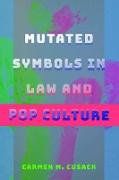- Start
- Mutated Symbols in Law and Pop Culture
Mutated Symbols in Law and Pop Culture
Angebote / Angebote:
Mutated Symbols in Law and Pop Culture plays with iconic representations of fusion, liminality, dispossession, and development. Mutations embody life because they illustrate phases and progression. Mutations and mutants fascinate the public. They are depicted by artists, including James Franco, Cary Elwes, Sara Bareilles, The Smashing Pumpkins, Quvenzhané Wallis, Pablo Picasso, Alicia Keys, Katy Perry, Debbie Reynolds, Maddie Ziegler, the Olsen twins, Mark McGrath, and Paul Simon. This book discusses physiological manifestations of mutations, such as beauty and specialness (e.g., white tigers), aesthetic (e.g., redheads), innovation (e.g., Mormonism), and prowess (e.g., tuxedos). Mutated Symbols in Law and Pop Culture focuses on strata that are popularly contemplated in culture and by the law, for example, primordial states (e.g., sleep), supranatural physicality (e.g., bionic), irresistible impulse (e.g., psychopath), queer semantic shift (e.g., "gay"), and class (e.g., Leo).
Mutated Symbols in Law and Pop Culture interweaves interdisciplinary analyses because mutations exceed defined ranges. For example, symbology and culture evocatively synergize in constitutional law. A symbol becomes legally protected if it is intended to communicate a particularized message that is likely to be understood by observers. This book demonstrates that mutations may not be sufficiently protected as speech. Even though the symbolism of mutations is the subject of study, the meaning of specific symbols may not be understood by the public. Symbols of mutation may identify cultural desires, embrace zeniths, and transform mundane or worn events into fantasies. Perhaps as a means of preserving, defending, and protecting mutations, culture has exhibited and spotlighted them.
Folgt in ca. 10 Arbeitstagen




